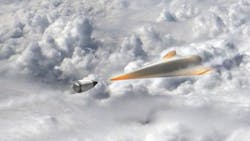Boeing to evaluate enabling technologies for future air-defense weapons that counter hypersonic missiles
ARLINGTON, Va. – U.S. military researchers are asking the Boeing Co. conduct wind-tunnel tests of futuristic air-defense weapon designed specifically to detect, track, and shoot-down enemy hypersonic munitions that are traveling at speeds of at least five times the speed of sound.
Officials of the U.S. Defense Advanced Research Projects Agency (DARPA) in Arlington, Va., announced a $70.6 million contract Friday to the Boeing Defense, Space & Security segment in Huntsville for the second phase of the Glide Breaker program.
The DARPA Glide Breaker project will develop enabling technologies critical for an advanced anti-missile weapon capable of defeating hypersonic vehicles, DARPA officials say. It is developing an advanced interceptor able to engage enemy maneuvering hypersonic threats in the upper atmosphere.
Glide Breaker phase-one contractors are Northrop Grumman Corp. and Aerojet Rocketdyne, which are developing control system prototypes, and are conducting component tests and static hot-fire demonstrations.
In phase-two, Boeing will conduct wind tunnel and flight testing of jet interaction effects to help validate models and steer future design work. One goal of phase-two is refining a divert and attitude control system (DACS), which enables an interceptor kill vehicle to target hypersonic missiles in flight.
On this contract Boeing will do the work in Huntsville, Ala.; Seal Beach, Calif.; St. Louis; Elkton, Md.; Buffalo, N.Y.; Gardner, Mass.; College Station, Texas; West Lafayette, Ind.; and in Minneapolis, and should be finished by February 2027.
For more information contact Boeing Defense, Space & Security online at www.boeing.com/company/about-bds, or DARPA at www.darpa.mil.
About the Author
John Keller
Editor-in-Chief
John Keller is the Editor-in-Chief, Military & Aerospace Electronics Magazine--provides extensive coverage and analysis of enabling electronics and optoelectronic technologies in military, space and commercial aviation applications. John has been a member of the Military & Aerospace Electronics staff since 1989 and chief editor since 1995.
